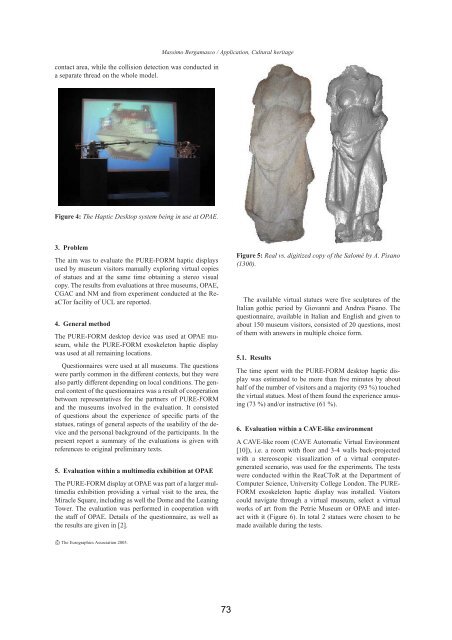full Paper - Nguyen Dang Binh
full Paper - Nguyen Dang Binh
full Paper - Nguyen Dang Binh
Create successful ePaper yourself
Turn your PDF publications into a flip-book with our unique Google optimized e-Paper software.
contact area, while the collision detection was conducted in<br />
a separate thread on the whole model.<br />
Figure 4: The Haptic Desktop system being in use at OPAE.<br />
3. Problem<br />
The aim was to evaluate the PURE-FORM haptic displays<br />
used by museum visitors manually exploring virtual copies<br />
of statues and at the same time obtaining a stereo visual<br />
copy. The results from evaluations at three museums, OPAE,<br />
CGAC and NM and from experiment conducted at the ReaCTor<br />
facility of UCL are reported.<br />
4. General method<br />
The PURE-FORM desktop device was used at OPAE museum,<br />
while the PURE-FORM exoskeleton haptic display<br />
was used at all remaining locations.<br />
Questionnaires were used at all museums. The questions<br />
were partly common in the different contexts, but they were<br />
also partly different depending on local conditions. The general<br />
content of the questionnaires was a result of cooperation<br />
between representatives for the partners of PURE-FORM<br />
and the museums involved in the evaluation. It consisted<br />
of questions about the experience of specific parts of the<br />
statues, ratings of general aspects of the usability of the device<br />
and the personal background of the participants. In the<br />
present report a summary of the evaluations is given with<br />
references to original preliminary texts.<br />
5. Evaluation within a multimedia exhibition at OPAE<br />
The PURE-FORM display at OPAE was part of a larger multimedia<br />
exhibition providing a virtual visit to the area, the<br />
Miracle Square, including as well the Dome and the Leaning<br />
Tower. The evaluation was performed in cooperation with<br />
the staff of OPAE. Details of the questionnaire, as well as<br />
the results are given in [2].<br />
c The Eurographics Association 2005.<br />
Massimo Bergamasco / Application, Cultural heritage<br />
73<br />
Figure 5: Real vs. digitized copy of the Salomé by A. Pisano<br />
(1300).<br />
The available virtual statues were five sculptures of the<br />
Italian gothic period by Giovanni and Andrea Pisano. The<br />
questionnaire, available in Italian and English and given to<br />
about 150 museum visitors, consisted of 20 questions, most<br />
of them with answers in multiple choice form.<br />
5.1. Results<br />
The time spent with the PURE-FORM desktop haptic display<br />
was estimated to be more than five minutes by about<br />
half of the number of visitors and a majority (93 %) touched<br />
the virtual statues. Most of them found the experience amusing<br />
(73 %) and/or instructive (61 %).<br />
6. Evaluation within a CAVE-like environment<br />
A CAVE-like room (CAVE Automatic Virtual Environment<br />
[10]), i.e. a room with floor and 3-4 walls back-projected<br />
with a stereoscopic visualization of a virtual computergenerated<br />
scenario, was used for the experiments. The tests<br />
were conducted within the ReaCToR at the Department of<br />
Computer Science, University College London. The PURE-<br />
FORM exoskeleton haptic display was installed. Visitors<br />
could navigate through a virtual museum, select a virtual<br />
works of art from the Petrie Museum or OPAE and interact<br />
with it (Figure 6). In total 2 statues were chosen to be<br />
made available during the tests.
















